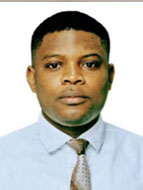Prerequisites
Students who are interested in Math. No prerequisite courses are required, but students need to go through a competitive admissions process.
Grade Level
Grade 11-12
Teacher Info

Mr. Paul Olaniba
Mr. Paul Olaniba is a high school teacher who has taught for more than five years in three different countries. Currently, he teaches Math and AP Economics at Guiyang Number 1 High School, Guizhou, China.
He previously taught at a high school in Shenzhen and Nanchang, China. He studied Accounting, Information Systems, and Finance at the European University of Lefke in Cyprus. He currently has three years of teaching experience in China. His teaching philosophy is to maintain a very engaging, friendly, and supportive classroom so that school becomes a joyful place for everyone to learn. In his spare time, he loves to explore his environment and spend time with his family.
Course Syllabus(For Reference Only)
| Week | Activities |
|
1 |
Week 1: Review of Basic Concepts of Algebra Read:
Do:
|
|
2 |
Week 2: Relations, Graphs, and Functions
Read:
Do:
|
|
3 |
Week 3: Transformations of Functions; Linear Functions, Absolute Value Functions, and Applications Read:
Do:
|
|
4 |
Week 4: Complex Numbers; Quadratic Equations, Functions and Applications
Read:
Do:
|
|
5 |
Week 5: Polynomial Functions, Rational Functions, Equations, and Inequalities
Read:
Do:
|
|
6 |
Week 6: Inverse, Radical, Exponential, and Logarithmic Functions
Read:
Do:
|
|
7 |
Week 7: Exponential and Logarithmic Properties, Equations and Applications
Read:
Do:
|
|
8 |
Week 8: Review and Final Exam
Do:
The ONLINE Final Exam is comprehensive, open book and includes multiple-choice and short answer questions. The final exam must be individually completed and represent your own personal work. Neither collaboration nor consultation with others is allowed. The solutions for the final exam will not be posted. |
Outcomes
After completing this course, you should be able to
1. demonstrate fluency in the language of college algebra and communicate mathematical ideas using appropriate terminology and technology
2. perform operations on real numbers, complex numbers, and functions, including composition of functions
3. solve linear, quadratic, rational, radical, exponential, logarithmic, and absolute value equations; and solve linear, polynomial, rational, and absolute value inequalities
4. analyze and graph circles and functions, including linear, piecewise, quadratic, higher order polynomial, rational, exponential, logarithmic, and inverse functions, and transformations of these functions
5. use mathematical modeling to translate, solve, and interpret applied problems related to linear and quadratic modeling, average rate of change, variation, and exponential growth and decay

